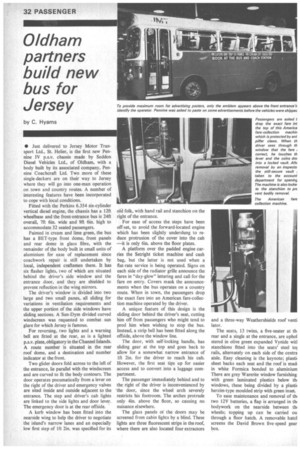Oldham partners build new bus for Jersey
Page 34

If you've noticed an error in this article please click here to report it so we can fix it.
by C. Hyams
• Just delivered to Jersey Motor Transport Ltd., St. Helier, is the first new Pennine IV p.s.v. chassis made by Seddon Diesel Vehicles Ltd., of Oldham, with a body built by its associated company, Pennine Coacheraft Ltd. Two more of these single-deckers are on their way to Jersey where they will go into one-man operation on town and country routes. A number of interesting features have been incorporated to cope with local conditions.
Fitted with the Perkins 6.354 six-cylinder vertical diesel engine, the chassis has a 12ft wheelbase and the front-entrance bus is 24ft overall, 7ft 6in. wide and 9ft 6in. high to accommodate 32 seated passengers.
Painted in cream and lime green, the bus has a BET-type front dome, front panels and rear dome in glass fibre, with the remainder of the body built in small units of aluminium for ease of replacement since coachwork repair is still undertaken by local, independent craftsmen there. It has six flasher lights, two of which are situated behind the driver's side window and the entrance door, and they are shielded to prevent reflection in the wing mirrors.
The driver's window is divided into two large and two small panes, all sliding for variations in ventilation requirements and the upper portion of the side windows have sliding sections. A Sun-Dym divided curved windscreen was requested to combat sun glare for which Jersey is famous.
For reversing, two lights and a warning bell are fitted at the rear, as is a lighted p. s.v. plate, obligatory in the Channel Islands. A route number is situated in the rear roof dome, and a destination and number indicator at the front.
Two glider doors fold across to the left of the entrance, lie parallel with the windscreen and are curved to fit the body contours. The door operates pneumatically from a lever on the right of the driver and emergency valves are sited inside and outside adjacent to the entrance. The step and driver's cab lights are linked to the side lights and door lever. The emergency door is at the rear offside.
A kerb window has been fitted into the nearside wing to help the driver to negotiate the island's narrow lanes and an especially low first step of 1 ft 2in. was specified for its
old folk, with hand rail and stanchion on the right of the entrance.
For ease of access the steps have been off-set, to avoid the forward-located engine which has been slightly underslung to reduce protrusion of the cover into the cab —it is only 6in. above the floor plates.
A platform over the padded engine carries the Setright ticket machine and cash bag, but the latter is not used when a flat-rate service is being operated. Signs on each side of the radiator grille announce the fares in "day-glow" lettering and call for the fare on entry. Covers mask the announcements when the bus operates on a country route. When in town, the passengers drop the exact fare into an American fare-collection machine operated by the driver.
A unique feature of this design is the sliding door behind the driver's seat, cutting him off from passengers who might tend to prod him when wishing to stop the bus. Instead, a strip bell has been fitted along the offside, above the window line.
The door, with self-locking handle, has sliding gear at the top and goes back to allow for a somewhat narrow entrance of lft 2in. for the driver to reach his cab. However, the first seat tips up for easier access and to convert into a luggage compartment.
The passenger immediately behind and to the right of the driver is inconvenienced by 'the door, since the wheel arch severely restricts his footroom. The arches protrude only 4in. above the floor, so causing no. nuisance elsewhere.
The glass panels of the doors may be screened from cabin lights by a blind. These lights are three fluorescent strips in the roof, where there are also located four extractors and a three-way Weathershields roof venti lator.
The seats, 13 twins, a five-seater at th, rear and a single at the entrance, are uphol stered in olive green expanded Vynide witl stanchions fitted into the seats' steel to] rails, alternately on each side of the centra aisle. Easy cleaning is the keynote; plastil sheet backs each seat and the roof is mad in white Formica bonded to aluminium There are grey Warerite window furnishing with green laminated plastics below tilt windows, these being divided by a plastii herzim-type moulded strip with green inset.
To ease maintenance and removal of thi two 12V batteries, a flap is arranged in till bodywork on the nearside between thi wheels; topping up can be carried ou through a floor hatch. A removable hatcl screens the David Brown five-speed gear box.




































































































